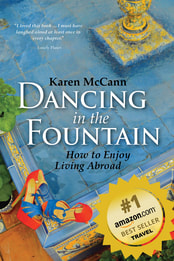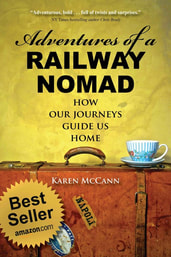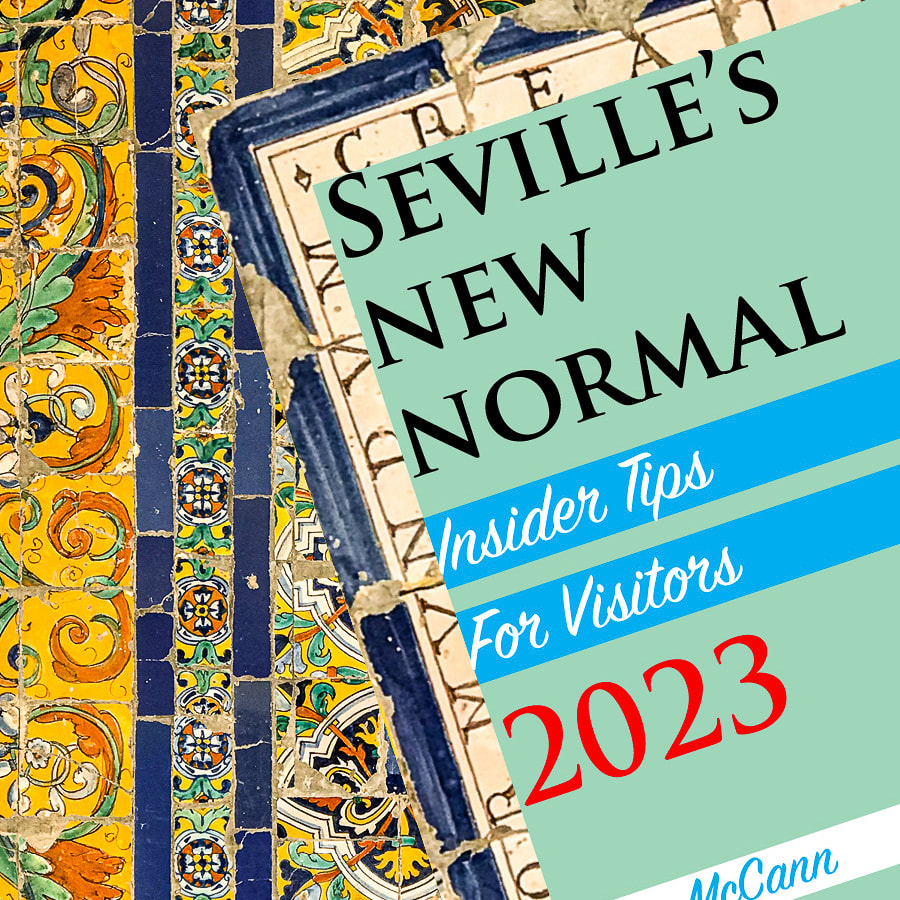 Civilized air travel has disappeared like the dodo. Civilized air travel has disappeared like the dodo. “You know what I hate about flying?” my friend D. once told me. “Knowing that the stranger sitting next to me paid half as much as I did for my ticket. Or a fifth. Or a tenth.” Pricing, and practically everything else about air travel, has become so convoluted and mystifying that it’s hard to tell fact from fiction any more. What ever happened to cheap stand-by fares? Are we any safer at the airports that make us remove our shoes than at those that don’t? Why do I have to take off my belt before passing through security? Do they think I’m going to hang myself if there’s a bottleneck and I miss my flight? I can’t clear up all all the confusion, but I have stumbled across hidden truths about three common air travel myths. Perhaps you’ll dismiss them as the rantings of a conspiracy nut (cue X Files theme music) but I think I’m onto something here.  Myth #1. Fluctuations in airfares are driven by random market forces and the Byzantine algorithms of the airlines; they have nothing to do with you. “When you’re shopping for tickets online,” my friend D. said recently, “have you noticed how those great prices you saw at the start of your search aren’t there when you go back to buy? That’s because when you’re browsing several sites, you’re leaving little cookies behind; that lets the airlines know you’re really interested, so they boost the prices. You think I’m being paranoid? Next time it happens, try emptying your cache of cookies.” (As you may know, cookies are the little trackers left on your computer after interactions with certain websites, letting them welcome you back by name, and, say, recommend books you may be interested in today.) The very next time Rich was booking a domestic flight, he noticed that the original price quoted had, after he’d checked competitive rates, gone up by $10. He emptied the cache of cookies (here’s how to do this) and the price instantly went back down to the original amount. Coincidence? I think not… 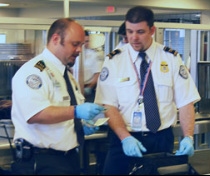 Myth #2. You absolutely, positively have to have a photo ID to get on a flight. Rich once went to present his ID at the San Francisco airport and discovered he’d left it at home. Obviously there was no way we’d get on our flight to LA, but in a Hail-Mary move, we appealed to security personnel. They bucked and snorted a bit, did an exhaustive examination of all the cards in Rich’s wallet and the contents of his suitcase, and subjected him to a body search that stopped just short of requiring that he strip naked on the spot. But they let him on. And it was obvious that they’d been through this rigmarole many times. It was routine.  Is seated flying on its way out? Is seated flying on its way out? Myth #3. Ryanair wants to make passengers ride standing rather than sitting, and will begin charging for use of toilets during flights. Ryanair was a pioneer in the field of making airline travel more annoying and uncomfortable, with seats clearly not designed by or for humans, and enticingly lean airfares that are soon bloated by extra fees for such transgressions as failing to print your own boarding pass in advance. But the recurring rumors about pay toilets and stand-up flights are, as near as I can tell, nothing but publicity stunts designed to provoke outraged articles that go viral in minutes, earning the penny-pinching airline tons of free publicity. Yes, I know, and here I am adding to it! When it comes to 21st century air travel, there are no guarantees. Did you ever think you’d have to pay for a glass of water on a plane? Watch fellow passengers travel in their pajamas? Have your legroom reduced – again? And there’s no telling how much worse it will get. Am I going to have to eat my words someday, when we all find ourselves flying standing up and paying to use the in-flight restrooms? If so, you’ll definitely be hearing more about that in future posts.
15 Comments
 Statue of Krakow's dragon. By Eirne/Wikimedia Statue of Krakow's dragon. By Eirne/Wikimedia I have nothing against the comforts and easy pleasures of a lighthearted holiday, but I’ll always choose adventure travel over a vacation. I simply feel more alive heading out into unknown territories that are the cultural equivalent of the spaces on the old maps marked “Here there be dragons.” But until I got to Kraków, Poland, it had never occurred to me that there might literally be dragons. Which just shows you how little I knew. Kraków’s dragon was called Smok Wawelski, and back in the day he was always ravaging crops, livestock, and maidens. When all the local knights had died fighting him, a poor but crafty cobbler’s apprentice named Skuba came up with a clever plan. He filled a lamb’s carcass with sulphur and laid it temptingly in front of the dragon’s cave. Smok gobbled it up and was seized with such a monstrous thirst that he ran down to the river and drank without ceasing until he exploded. Problem solved!  Smok's bones at Wawel Cathedral Smok's bones at Wawel Cathedral And I know every word of this is true, because I have seen Smok’s bones, mounted at the entrance to the cathedral in the Wawel Castle complex. Naturally there weren’t many bones left after he exploded, and as our guide was telling the story, Rich was craning his neck in an unsuccessful attempt to see them. Finally he leaned over and whispered, “Where are the bones?” Unfortunately, he whispered this into the ear of a strange woman with my color hair who happened to be standing next to him at the time. A few awkward moments ensued until the woman’s male companion, evidently deciding Rich was a harmless lunatic, pointed to the rafters and said, “Up there.” Chained high on the wall were three bones of gargantuan size, two massive joints and what looked like a long, curved rib. Now, I know you’ll find this hard to credit, but some naysayers have seen fit to question the authenticity of these bones, suggesting they might be from a blue whale, a rhinoceros, and/or a wooly mammoth rather than an actual dragon. However the chances of those bones being taken down and subjected to scientific scrutiny are precisely zilch, because according to legend, so long as they remain in place, Kraków is safe from destruction. Are they working? You bet. Otherwise, how would you account for the fact that during World War II, when just about every major city in Poland was bombed to rubble, Kraków survived more or less intact?  Feeling the Force of the Wawel Chakra Stone? Feeling the Force of the Wawel Chakra Stone? Well, there is one other reason that could account for the city’s survival: the Wawel Chakra Stone. If you’re a little hazy on the whole chakra thing, they’re sites of highly concentrated physical and spiritual energy. The human body has seven, from the root chakra at the base of the spine to the thousand-petaled lotus of enlightenment at the top of the head. The Earth also has seven chakras, marked by stones that radiate transformative and protective power. One is said to be inside a wall in Wawel Castle, where it’s busy cleansing the earth’s aura and reanimating the seventh chakras of those who touch the wall. Do you have to ask? Of course, I tried it! I placed my palm against the wall and leaned in. Nothing whatsoever happened. Or did it? For all I know, my spiritual batteries are fully topped up, all thousand petals of my lotus are open, and my seventh chakra is doing a happy dance – but all in ways too subtle for me to notice. 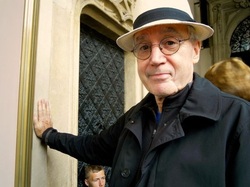 Rich was a tad skeptical. Rich was a tad skeptical. I will never know if those are real dragon bones or whether the chakra stone gave my aura a bit more zing. But I am certain that visiting Wawel Castle let me step outside the boundaries of my ordinary life and open myself up, if only briefly, to some of the mysteries of the universe. And who knows, maybe as I continue exploring unknown territories, the protective powers of the Wawel Chakra Stone will be keeping me safe along the way.  The subhead reads: "February 14 is Bombshell Day." Yeah, right. The subhead reads: "February 14 is Bombshell Day." Yeah, right. I have to confess, I’m not a huge fan of Valentine’s Day. As regular readers of this blog know, I love most holidays and jump at almost any excuse, however flimsy, for a celebration. But to me, Valentine’s Day has a forced feeling, even worse than the obligatory jollity of New Year’s Eve. It’s hard to shake the feeling that if Rich and I don’t manage to set new world records for glamour, intimacy, and passion, to say nothing of clothing, food, and wine, the evening – and, let’s face it, our entire relationship – is an abysmal failure. But no pressure. It’s not that Rich and I aren’t romantic. Why, this is the man who gave me a compost tumbler one year for Christmas. We were living in Ohio at the time, diligently collecting our table scraps to provide nutrients for our vegetable garden. The previous owners had started a compost pile in the woods at the edge of our property, a short but bone-chilling hike in Cleveland’s long snow season, and I was thrilled to have an efficient new compost tumbler installed on my back doorstep. My sisters in California were appalled, but I was the envy of all our Ohio neighbors. Then there was the time that I was annoyed with Rich about something — I have long since forgotten what — and expressed my opinion of the matter, and of him, rather freely and with an unbecoming frankness that ended with me stomping past him into the bedroom. And there I found, laid tenderly on my pillow, an envelope with a poem inside expressing, in the most charming and romantic words possible, the depths of his love for me. I remember in particular some comments on how he never tired of my sweet voice. I felt lower than the slimiest worm crawling about in our compost tumbler. Which of course, Rich found hilarious. The rat. All in all, Rich and I prefer our romance to be spontaneous and heartfelt, and we don’t tend to make much of Valentine’s Day. It’s more of an action movie, beer, and potato chip kind of holiday with us. All in all, Rich and I prefer our romance to be spontaneous and heartfelt, and we don’t tend to make much of Valentine’s Day. It’s more of an action movie, beer, and potato chip kind of holiday with us. Singles I know go out to the movies, stay at home with a stack of library books, or plan other ways to pass the evening without setting foot in a restaurant, knowing they’ll all be filled with glittering couples holding hands and ordering more oysters and champagne. Last year I read an article by a woman who invites all her unmarried, divorced, separated, widowed, and celibate friends over for a long, wine-soaked pot-luck meal in celebration of fellowship. She wrote that it has now become one of her favorite nights of the year. However you choose to spend February 14, I hope you’ll join me in resisting the efforts of Madison Avenue, Hollywood, the clothing industry, florists, jewelers, trendy restaurants, Godiva, and Hallmark to convince us all that this should be the most spectacular night in the history of the world, again this year. Be happy doing something simple and fun, possibly involving George Clooney, potato chips, and a compost tumbler. Happy Valentine’s Day.  I love bookstores. I also love 1962 VW Bugs, my vinyl copy of the Beatle’s White Album, and coffee that costs less than a dollar a cup. But despite what John Lennon wrote, love isn’t all you need, at least not when you’re running a commercial enterprise. And one fact that's rarely mentioned in all the recent articles raising the alarm about bookstores as an endangered species is that a bookstore is a commercial enterprise. It survives by selling you books. And when another seller does that better, it’s going to succeed. It deserves to. Yes, I’m talking about the 800-pound gorilla, Amazon. They figured out how to improve your buying experience with ratings, reviews, and the opportunity to read a solid sample of the book before you plunk down your money. And they offer 11,000,000+ titles, compared to a chain bookstore’s 30,000.  Another fact that’s often overlooked is that reading is a solitary activity, not a social one. Journalists wax nostalgic about the neighborhood bookstore as a cozy sanctuary in which people gather on comfy furniture for a leisurely read. Really? When was the last time you did long, leisurely reading in a bookstore? In my case, never. And I’m a voracious reader. People browse, skim, and explore in a store, but most serious reading happens at home. Then there’s the cost. With the average hardcover book priced at $26 (19€), bookstores are becoming a rich person’s luxury. I recently asked fellow members of an authors-and-readers Facebook group how they felt about bookstores, libraries, and e-books. And the overwhelming response was that everyone loves the feel of a “real” book – but most use an e-reader. As one put it, “e-books are a much cheaper alternative than a new paperback, and as for hardback books – well, [you'd] need to take out a loan!”  The sad-demise articles also bemoan the loss of bookstores as community centers where authors lecture, kindly old ladies read books to small children, and book clubs meet to discuss great literature. Public libraries deliver all that and much more – for free. Nowadays, free public libraries offer everyone the joy of an endless supply of books, and, in the American system at least, e-books, audio books, movies, music, technology courses, assistance with college applications, video games, online language courses, voter information, and so much more. They remind us that words matter, that life is bigger than we could possibly have imagined, and that, as writer William Nicholson put it, "We read to know that we are not alone." While working on this post, I was corresponding with Alicia Bay Laurel, author of the New York Times bestseller Living on the Earth, published in 1971 and updated in 2003. When I was in college in Berkeley, everyone had her book on their shelf, right next to Ram Dass’s Be Here Now and Our Bodies, Ourselves. I had long since lost my copy (which come to think of it, belonged to my roommate) and wanted the new edition. Since it’s all about living organically, in harmony with the universe, it’s naturally not available electronically. Our public library system had both print versions, but I wanted to own this one. So I thought, “Great, it’s been ages since I shopped in that cozy, little independent bookstore in my neighborhood.”  Mural on the now-defunct Book Beat in Fairfax, CA Mural on the now-defunct Book Beat in Fairfax, CA The clerk had never heard of the book, and after searching online, he declared it impossible to get. So I went to a larger independent bookstore, and they directed me to “the guy with the white hair at the back desk.” He and I shared a delightful fifteen minutes reminiscing about the hippie movement, campus unrest in Berkeley, Ram Dass, and Alicia’s book. And then he also checked his computer and declared her book out of print and unavailable. So I went on Amazon, which offered the original in paperback, and the updated edition in hardbound and paperback, in new, used, and collectable editions. I bought a used copy (which seemed more in the spirit of the book) for $11.25 and it arrived on my doorstep in two days with free shipping. And people wonder why bookstores aren’t making it. |
This blog is a promotion-free zone.
As my regular readers know, I never get free or discounted goods or services for mentioning anything on this blog (or anywhere else). I only write about things I find interesting and/or useful. I'm an American travel writer living in California and Seville, Spain. I travel the world seeking eccentric people, quirky places, and outrageously delicious food so I can have the fun of writing about them here.
My current project is OUT TO LUNCH IN SAN FRANCISCO. Don't miss out! SIGN UP HERE to be notified when I publish new posts. Planning a trip?
Use the search box below to find out about other places I've written about. Winner of the 2023 Firebird Book Award for Travel
#1 Amazon Bestseller in Tourist Destinations, Travel Tips, Gastronomy Essays, and Senior Travel
BLOG ARCHIVES
July 2024
CATEGORIES
All
|






